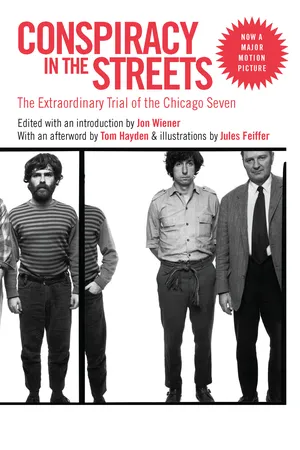
Conspiracy in the Streets
The Extraordinary Trial of the Chicago Seven
- English
- ePUB (mobile friendly)
- Available on iOS & Android
About this book
THE TRIAL THAT IS NOW A MAJOR MOTION PICTURE
Reprinted to coincide with the release of the new Aaron Sorkin film, this book provides the political background of this infamous trial, narrating the utter craziness of the courtroom and revealing both the humorous antics and the serious politics involved
Opening at the end of 1969—a politically charged year at the beginning of Nixon's presidency and at the height of the anti-war movement—the Trial of the Chicago Seven (which started out as the Chicago Eight) brought together Yippies, antiwar activists, and Black Panthers to face conspiracy charges following massive protests at the 1968 Democratic National Convention in Chicago, protests which continue to have remarkable contemporary resonance.
The defendants—Rennie Davis, Dave Dellinger, John Froines, Tom Hayden, Abbie Hoffman, Jerry Rubin, Bobby Seale (the co-founder of the Black Panther Party who was ultimately removed from the trial, making it seven and not eight who were on trial), and Lee Weiner—openly lampooned the proceedings, blowing kisses to the jury, wearing their own judicial robes, and bringing a Viet Cong flag into the courtroom. Eventually the judge ordered Seale to be bound and gagged for insisting on representing himself. Adding to the theater in the courtroom an array of celebrity witnesses appeared, among them Timothy Leary, Norman Mailer, Arlo Guthrie, Judy Collins, and Allen Ginsberg (who provoked the prosecution by chanting "Om" on the witness stand).
This book combines an abridged transcript of the trial with astute commentary by historian and journalist Jon Wiener, and brings to vivid life an extraordinary event which, like Woodstock, came to epitomize the late 1960s and the cause for free speech and the right to protest—causes that are very much alive a half century later. As Wiener writes, "At the end of the sixties, it seemed that all the conflicts in America were distilled and then acted out in the courtroom of the Chicago Conspiracy trial."
An afterword by the late Tom Hayden examines the trial's ongoing relevance, and drawings by Jules Feiffer help recreate the electrifying atmosphere of the courtroom.
Frequently asked questions
- Essential is ideal for learners and professionals who enjoy exploring a wide range of subjects. Access the Essential Library with 800,000+ trusted titles and best-sellers across business, personal growth, and the humanities. Includes unlimited reading time and Standard Read Aloud voice.
- Complete: Perfect for advanced learners and researchers needing full, unrestricted access. Unlock 1.4M+ books across hundreds of subjects, including academic and specialized titles. The Complete Plan also includes advanced features like Premium Read Aloud and Research Assistant.
Please note we cannot support devices running on iOS 13 and Android 7 or earlier. Learn more about using the app.
Information
Table of contents
- Cover Page
- Title Page
- Contents
- List of Illustrations
- Acknowledgments
- Editor’s Note
- Introduction: The Sixties on Trial by Jon Wiener
- Chronology
- Trial Transcript
- I. Opening Statements
- II. The Government’s Case
- III. The Case for the Defense
- IV. Rebuttal Case for the Government 203 James Riordan, Chicago’s deputy chief of police
- V. Closing Arguments and Jury Instructions
- VI. Contempt Proceedings
- VII. Verdicts and Sentencing
- Afterword by Tom Hayden
- Notes
- Copyright Page